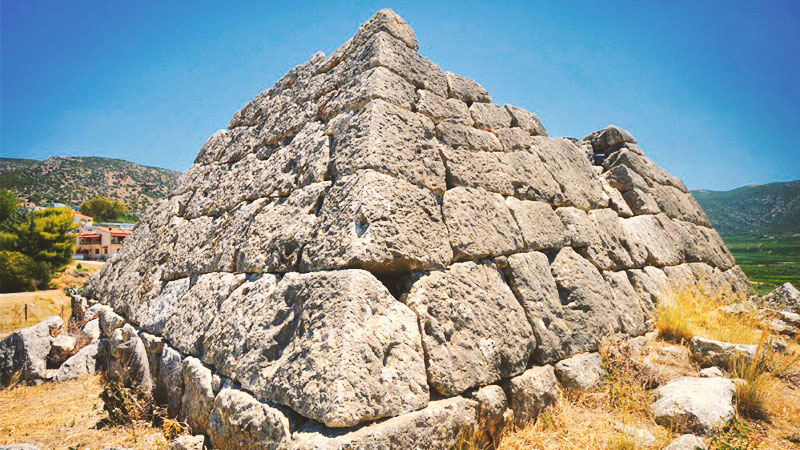
Whenever we hear the word “Pyramid”, our minds turn to ancient Egypt and its majestic megalithic buildings.
However, although Egypt is known for its three main pyramids on the Giza plateau, the truth is that there are thousands of pyramids scattered across the globe.
Many of these ancient pyramid-shaped buildings have been found in southern Greece, and the most impressive of them is located near hellinikon village in Argos in the Eastern Peloponnese.
Two other unique pyramid-shaped structures also impress, one of which is the cone-shaped pyramid of Chania, located on the island of Crete, and the Pyramid of Rock, which forms the peak of Mount Taygetus and divides the Peloponnesus from the rest of mainland Greece, mentioned in Homer’s epic “Odyssey”, which is also known as the summit of the Prophet Elijah from the Bible.
Professor Ioannis Liritzis, a regular researcher of these ancient megalithic structures, argues that there are more than 20 ancient Greek pyramids located in Astros, south of Argos, neochori, east Of Thessaly, agios Andreas, on Mount Parnassos, north of Beotia and that, according to ancient Greek mythology, it was one of the residences of the god Apollo and his muses, and elsewhere dating back up to 11,000 BC.
Unfortunately many of these structures suffered serious and irreparable damage by the action of time.
The Pyramid of Hellinikon

The “Pyramid of Hellinikon” is a pyramidal historical monument, located in the Argos area.
Its first dating occurred in 1938, by an American archaeological expedition, and concluded that it was built approximately in the 4th century BC.
A more recent survey, conducted in 1991 by Professor J. Lyrintzis, used new dating methods and proved that this monument belongs to a much earlier period, more specifically around the year 3,000 BC.
However, in 1995, new measurements were taken by the Archeometry Laboratory of the Academy of Athens and the Nuclear Dating Laboratory of the Department of Physics at the University of Edinburgh in Scotland, and dated the monument to the year 2,720 BC.
This means that the Hellinikon Pyramid is at least 170 years older than the Pyramid of Cheops in Egypt and 100 years prior to the construction of the Pyramid of Djoser, egypt’s oldest, dating from the year 2620 BC., although the age of the Egyptian pyramids and the sphinx is a controversial topic.
The true purpose of the Hellinikon monument remains unknown, although some experts have theorized that the structure was built as a tribute to the heroes of a battle that took place at the site.
The Pyramid of Hellinikon, now in ruins, was well described in ancient times and the ancient Greek traveler and geographer Pausânias documented in his book “Description of Greece” of the 2nd century the following:
“On the way from Argos to Epidauria, there is on the right a building much like a pyramid, and on it embossed are shields carved in argiva form.
Here there was a struggle for the throne between Proetus and Acrisius; the dispute, they say, ended in a draw and then there was a reconciliation, as neither of them achieved a decisive victory.
The story is that they and their hosts were armed with shields, which were first used in this battle. For those who fell on each side a common tomb was built here, for they were fellow citizens and relatives.”
Although nothing has been found within the walls of the pyramid that provides evidence of a royal tomb, the mystery of the Pyramid of Hellenikon is certainly intriguing.

Although incomparable in size with its Egyptian counterparts, the Pyramid of Hellinikon, with its external faces tilted and surrounding a rectangular building, measure 7 by 9 meters and was built with gray limestone from the area, along with large blocks in a trapezoidal and partially polygonal system.
Despite the immense significance of this great discovery to our understanding of the early civilizations, strangely the excavation of this ancient monument at Hellinikon has been abandoned, and its real history is almost lost today.



















